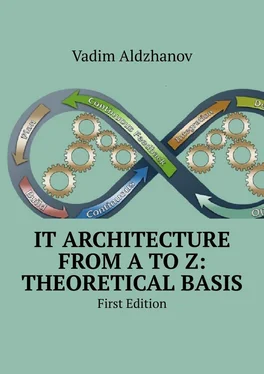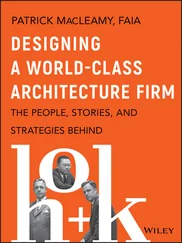The Main Aspects of Enterprise Architecture
To fight the above-mentioned problems and consequences, the Enterprise Architecture helps shape the following important criteria.
Structuring the Enterprise
When building an Enterprise Architecture, the first and most important aspect is an understanding of the enterprise’s organizational structure, principles of management, decision-making, etc. The organizational structure is a fixed and ordered set of objects and connections between them. Depending on the specialization and operations the organization may have:
•Vertical structure – in terms of subordination
•Horizontal structure – in terms of functions and operations.
Accordingly, the management structures are distinguished as linear based on “chief – subordinate” principle and functional, i.e. “professional integration based on the operational specifics”. As a result, organization structure can be represented as the following main types and their varieties:
• Flat, the simplest structure, is suitable for work or project teams, or a small organization.
• Breakdown (bureaucratic) is based on the organizational structure, the functional division of labor and employees’ responsibilities.
• Linear, direct control (head – subordinate), communication between departments occurs through heads of departments only.
• Functional, interaction is based on function.
• Linear-functional – the interaction is combined in a linear and functional type (the most used model).
• Linear and staff – separate functional groups (staffs), conducting work independently with departments or organizations. As an example, a group of companies in the holding.
• Divisional is characterized by central coordination with decentralized management. The key figures in this case are not the heads of functional units, but the managers of individual branches, factories, and so on.
• Organic (adaptive) – the structure formation is based on the need to adapt to changes. Relationships are based not on the structure, but on the nature of the objectives set.
• Project – organized during project management.
• Matrix (program-targeted) – the principle of dual reporting, direct reporting to the manager and project manager
• Brigade (cross functional) – work in separate groups with independent management and decision-making (contrary to breakdown).
Organizational structure may depend on a number of factors:
•Specificity and diversity of operations;
•Geographical location;
• The centralization level of the organization;
• Organization strategy;
• Number and range of services provided.
IT role in the organization
One of the main criteria of building an Enterprise Architecture is to identify the IT role within the organization. If we ignore articles and recommendations about the importance of IT in the modern world given by consultants and other small talks, we have to rigidly fix the role of IT in the organization, the objectives, rights, opportunities and degree of responsibility. To understand the IT role in a particular organization, one needs to answer the following questions:
How is IT involved in business? How much does business depends on IT? Many business processes and functions are tied to complex, centralized or specific IT solutions. Business development is impossible without rapid and quality IT work. There are entire industries that depend on IT such as banks, insurance companies, other financiers, service companies, Public agencies, technology and power companies, etc. (as an example, two-thirds of the bank employees work in one way or another with a centralized banking program, while only a few rural organizations use mostly autonomous IT solutions, where majority the employees work on the field or the computerization of the company is low).
Whether your organization can be attributed to large or medium-scale business. In my opinion, as long as all the technologies of the company are stored in one head, and the CIO communicates directly with the management it is too early to think about the enterprise architecture. For small-scale businesses, enterprise architecture is superfluous.
Whether your company is actively developing IT. The company has several IT projects per year, or at least one project on implementing ERP, CRM or other complex solution. Enterprise Architecture will help to make a decision save from most alterations, errors, inconsistencies, delays and other problems. There must be one person, or groups of people in the company to have a general picture of the future and understand the development process. Otherwise, the pieces of different projects will never make a puzzle.
Whether the company periodically faces IT crises having a significant impact on the business, or there are failures in information systems affect the business and even stops it. Failures are caused by integration problems, miscalculations in infrastructure solutions, temporary solutions and just a mess. Not all projects, including IT, end successfully, meeting the deadlines, budget and stated requirements. If your company management is fed up with failures, delays, exceeding the budgets of IT projects, it is worth thinking.
Companies are looking for speed, quality and efficiency of IT development. One of the parties (business or IT) is developing much faster than the other one. If business develops faster than IT, the latter one impedes the company’s development. Conversely, if IT develops faster than the business needs, business lose money (good IT costs money) and profits (the business does not use all the potential IT capabilities). Both parties should be on the same wavelength to allow the harmonious development of all company’s elements.
Building a relationship between business and IT
IT actions should be focused on business goals and objectives. Business and IT parties see the objectives, goals and expectations differently. This is what IT staff says “…we are good in technology, we are paid for the ability to program, configure, install and solve technical problems, etc. Our work commences as we receive the statement of work…". While business sees it as “…there are so many IT innovations, IT should give us some kind of solution to increase sales. In the worst case scenario, we need a solution our competitors already have. So their sales are higher …you are welcome to implement it since you’ve made a decision though you don’t understand how this business works…”. The task of the CIO is to have an equal share in the discussion of business strategy. The general principle can be defined as: “a business describes its requirements and expectations (business requirements), while IT creates a statement of work to achieve the goals.”
Establishing collaboration between business and IT
All above mentioned is followed by another important problem, i.e. the “vacuum” in communication between business and IT employees. The task of the organization’s management and the CIO is to establish communication between the organization’s employees not only at the top-level, but also between the middle-level employees and the direct executors of business and IT. As the saying goes “the devil is in the details.” Any cool idea in general should be fine-tuned. At this stage, the specific thinking of IT specialists with having causal link, and WH-questions such as “…what happens if…,”, “… how to control…”, “…how to measure …”, as well as analysis of limit state scenarios, will help develop an optimal solution. In addition, such questions will help business representatives to understand and work out the solution from a business point of view and what to demand from IT, the ongoing solution capabilities and their future opportunities or limitations.
Читать дальше












